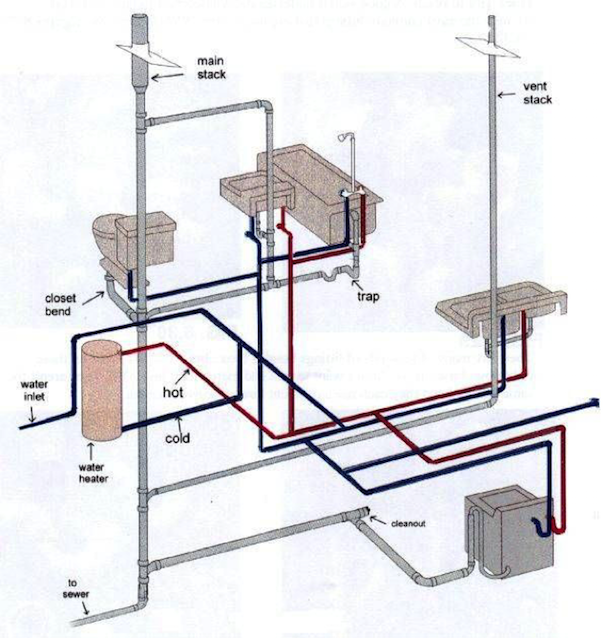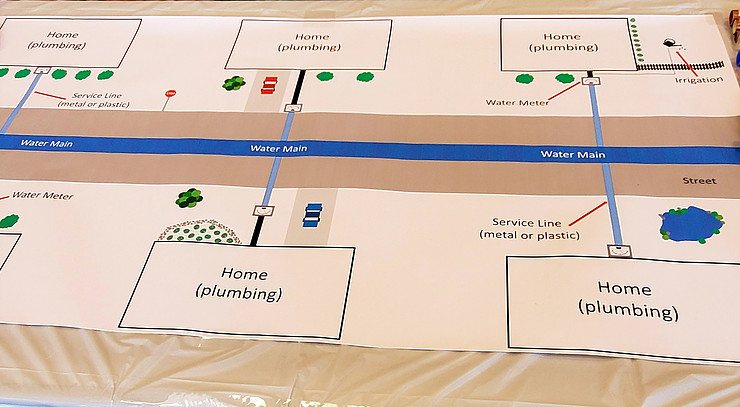Just how do you actually feel with regards to Understanding Your Home's Plumbing Anatomy?

Understanding how your home's plumbing system works is important for every homeowner. From providing tidy water for alcohol consumption, cooking, and bathing to safely removing wastewater, a well-maintained plumbing system is vital for your family members's health and wellness and convenience. In this extensive guide, we'll explore the elaborate network that comprises your home's plumbing and deal pointers on upkeep, upgrades, and managing common issues.
Introduction
Your home's pipes system is greater than simply a network of pipes; it's a complex system that ensures you have accessibility to tidy water and effective wastewater removal. Knowing its components and just how they interact can aid you stop expensive repair services and make certain every little thing runs efficiently.
Standard Elements of a Plumbing System
Pipes and Tubes
At the heart of your plumbing system are the pipes and tubes that lug water throughout your home. These can be made from various products such as copper, PVC, or PEX, each with its advantages in terms of longevity and cost-effectiveness.
Components: Sinks, Toilets, Showers, and so on.
Fixtures like sinks, commodes, showers, and bathtubs are where water is made use of in your house. Comprehending exactly how these fixtures link to the pipes system assists in diagnosing troubles and planning upgrades.
Valves and Shut-off Factors
Valves control the circulation of water in your plumbing system. Shut-off shutoffs are essential during emergency situations or when you require to make repair services, allowing you to isolate parts of the system without interrupting water circulation to the entire residence.
Water Supply System
Main Water Line
The major water line attaches your home to the community water system or a private well. It's where water enters your home and is distributed to numerous components.
Water Meter and Pressure Regulator
The water meter steps your water use, while a pressure regulator ensures that water streams at a risk-free stress throughout your home's pipes system, preventing damage to pipes and fixtures.
Cold Water vs. Hot Water Lines
Comprehending the difference in between cold water lines, which provide water straight from the major, and hot water lines, which carry heated water from the water heater, aids in repairing and planning for upgrades.
Drainage System
Drain Pipeline and Traps
Drain pipes bring wastewater away from sinks, showers, and toilets to the sewer or septic tank. Traps prevent drain gases from entering your home and likewise catch debris that could cause clogs.
Ventilation Pipelines
Ventilation pipes permit air right into the drainage system, avoiding suction that might reduce drain and trigger catches to vacant. Correct air flow is important for preserving the honesty of your pipes system.
Relevance of Proper Drainage
Ensuring proper drainage stops back-ups and water damages. On a regular basis cleansing drains pipes and keeping catches can prevent costly repairs and extend the life of your pipes system.
Water Heating System
Sorts Of Hot Water Heater
Water heaters can be tankless or traditional tank-style. Tankless heating systems warmth water on demand, while tanks save warmed water for instant use.
How Water Heaters Attach to the Pipes System
Recognizing just how hot water heater attach to both the cold water supply and warm water distribution lines helps in diagnosing concerns like inadequate hot water or leaks.
Upkeep Tips for Water Heaters
Frequently flushing your hot water heater to eliminate debris, inspecting the temperature settings, and inspecting for leakages can extend its life-span and enhance energy effectiveness.
Common Pipes Problems
Leakages and Their Causes
Leaks can occur as a result of aging pipelines, loose installations, or high water pressure. Resolving leaks promptly protects against water damage and mold and mildew growth.
Blockages and Blockages
Obstructions in drains and commodes are commonly triggered by flushing non-flushable things or a buildup of oil and hair. Making use of drainpipe screens and bearing in mind what decreases your drains pipes can avoid obstructions.
Indications of Pipes Problems to Look For
Low tide pressure, sluggish drains pipes, foul odors, or unusually high water bills are indications of prospective plumbing troubles that should be resolved promptly.
Plumbing Upkeep Tips
Regular Evaluations and Checks
Set up yearly pipes evaluations to catch concerns early. Try to find indicators of leaks, corrosion, or mineral accumulation in faucets and showerheads.
DIY Upkeep Tasks
Straightforward tasks like cleaning faucet aerators, looking for commode leaks utilizing color tablet computers, or insulating subjected pipelines in chilly environments can stop major plumbing issues.
When to Call an Expert Plumbing Professional
Know when a pipes problem needs specialist knowledge. Attempting intricate repairs without proper understanding can bring about more damage and greater fixing costs.
Upgrading Your Plumbing System
Reasons for Updating
Updating to water-efficient fixtures or replacing old pipes can enhance water high quality, lower water bills, and increase the value of your home.
Modern Pipes Technologies and Their Advantages
Explore technologies like wise leak detectors, water-saving bathrooms, and energy-efficient hot water heater that can save money and decrease environmental effect.
Expense Considerations and ROI
Determine the ahead of time costs versus long-term savings when considering plumbing upgrades. Many upgrades pay for themselves with decreased utility expenses and fewer repair work.
Environmental Impact and Preservation
Water-Saving Components and Appliances
Installing low-flow faucets, showerheads, and toilets can significantly reduce water use without sacrificing efficiency.
Tips for Decreasing Water Use
Basic routines like taking care of leakages without delay, taking much shorter showers, and running complete tons of laundry and recipes can preserve water and reduced your energy expenses.
Eco-Friendly Plumbing Options
Consider lasting pipes materials like bamboo for flooring, which is durable and environmentally friendly, or recycled glass for countertops.
Emergency Readiness
Actions to Take During a Plumbing Emergency situation
Know where your shut-off shutoffs lie and exactly how to turn off the water in case of a ruptured pipe or significant leakage.
Value of Having Emergency Contacts Convenient
Keep contact details for regional plumbing technicians or emergency solutions easily available for fast reaction throughout a pipes crisis.
Do It Yourself Emergency Fixes (When Applicable).
Short-lived repairs like using air duct tape to patch a dripping pipe or positioning a container under a dripping tap can minimize damages up until a specialist plumbing technician arrives.
Verdict.
Understanding the makeup of your home's pipes system encourages you to preserve it effectively, conserving time and money on repair services. By following routine maintenance regimens and staying educated about modern-day plumbing innovations, you can ensure your pipes system runs efficiently for many years ahead.
HOW YOUR PLUMBING SYSTEM WORKS
Which Pipes Do What?
Blue lines = fresh water supply entering the building
Red lines = hot water supply entering the building
Grey lines = pipes carrying waste away from the building and venting pipes carrying gases away from the building (through the roof)
YOUR MAIN PLUMBING SYSTEMS
There are two main plumbing systems that support your home s basic plumbing needs one that brings clean water into your home, and one that sends dirty water away from your home. Connected to the toilet, bath, shower, and other faucets in your home, these two systems keep your water flowing in the right directions.
ACCESSING FRESH WATER
Fresh and clean water is brought into your home through the main water supply line . Filtered through one pipe, this water is pressured to flow into the various fixtures in your home at any given time.
This water can be sourced from a well located on your property, a pond or river (mostly cottages), or, as in most cases, from the city s municipal water treatment centre. However, it is important to note that water that is untreated, such as the water siphoned from ponds or rivers, may not be safe to drink. Personal water supplies always need to be treated for hardness and contaminants before consumed.
MUNICIPAL WATER SUPPLIES
Improve taste and odour
Remove sediment
Eliminate hardness
Reduce chlorine
COLD WATER SUPPLY VS. HOT WATER SUPPLY
Cold water flows into your home or building through the service line, which then distributes hot or cold water to your fixtures. This line is most commonly run through a central column that runs floor to floor. Hot water runs in short and straight pipes as the longer the pipeline, the more heat that will be lost in the transfer. Having shorter pipes also allows residents to access hot water more quickly.
WASTE WATER SYSTEM
Your wastewater system is divided into two parts pipes that send wastewater away from your home and venting pipes that send sewer gas away from your home. Sewage water travels through pipes that flush the water and waste towards local sewers that are operated and managed by your city or town. Most sewer systems rely on gravity to move the wastewater to where it needs to go.
The further away from your toilet or sink, the larger wastewater pipes become. This allows for waste to be disposed of from various parts of your home or business at once without pipe blockages. The angle and flow of these pipes are also essential for keeping your waste pipes clear of build up.
https://harrisplumbing.ca/how-your-home-plumbing-system-works/

HOW YOUR PLUMBING SYSTEM WORKS
Which Pipes Do What?
YOUR MAIN PLUMBING SYSTEMS
There are two main plumbing systems that support your home s basic plumbing needs one that brings clean water into your home, and one that sends dirty water away from your home. Connected to the toilet, bath, shower, and other faucets in your home, these two systems keep your water flowing in the right directions.
ACCESSING FRESH WATER
Fresh and clean water is brought into your home through the main water supply line . Filtered through one pipe, this water is pressured to flow into the various fixtures in your home at any given time.
This water can be sourced from a well located on your property, a pond or river (mostly cottages), or, as in most cases, from the city s municipal water treatment centre. However, it is important to note that water that is untreated, such as the water siphoned from ponds or rivers, may not be safe to drink. Personal water supplies always need to be treated for hardness and contaminants before consumed.
MUNICIPAL WATER SUPPLIES
COLD WATER SUPPLY VS. HOT WATER SUPPLY
Cold water flows into your home or building through the service line, which then distributes hot or cold water to your fixtures. This line is most commonly run through a central column that runs floor to floor. Hot water runs in short and straight pipes as the longer the pipeline, the more heat that will be lost in the transfer. Having shorter pipes also allows residents to access hot water more quickly.
WASTE WATER SYSTEM
Your wastewater system is divided into two parts pipes that send wastewater away from your home and venting pipes that send sewer gas away from your home. Sewage water travels through pipes that flush the water and waste towards local sewers that are operated and managed by your city or town. Most sewer systems rely on gravity to move the wastewater to where it needs to go.
The further away from your toilet or sink, the larger wastewater pipes become. This allows for waste to be disposed of from various parts of your home or business at once without pipe blockages. The angle and flow of these pipes are also essential for keeping your waste pipes clear of build up.
https://harrisplumbing.ca/how-your-home-plumbing-system-works/
As an enthusiastic person who reads on Plumbing Installation 101: All You Need to Know, I thought sharing that chunk was a good idea. Don't hesitate to pause to promote this post if you enjoyed it. Thanks a lot for being here. Kindly pay a visit to our website back soon.
Request Appointment